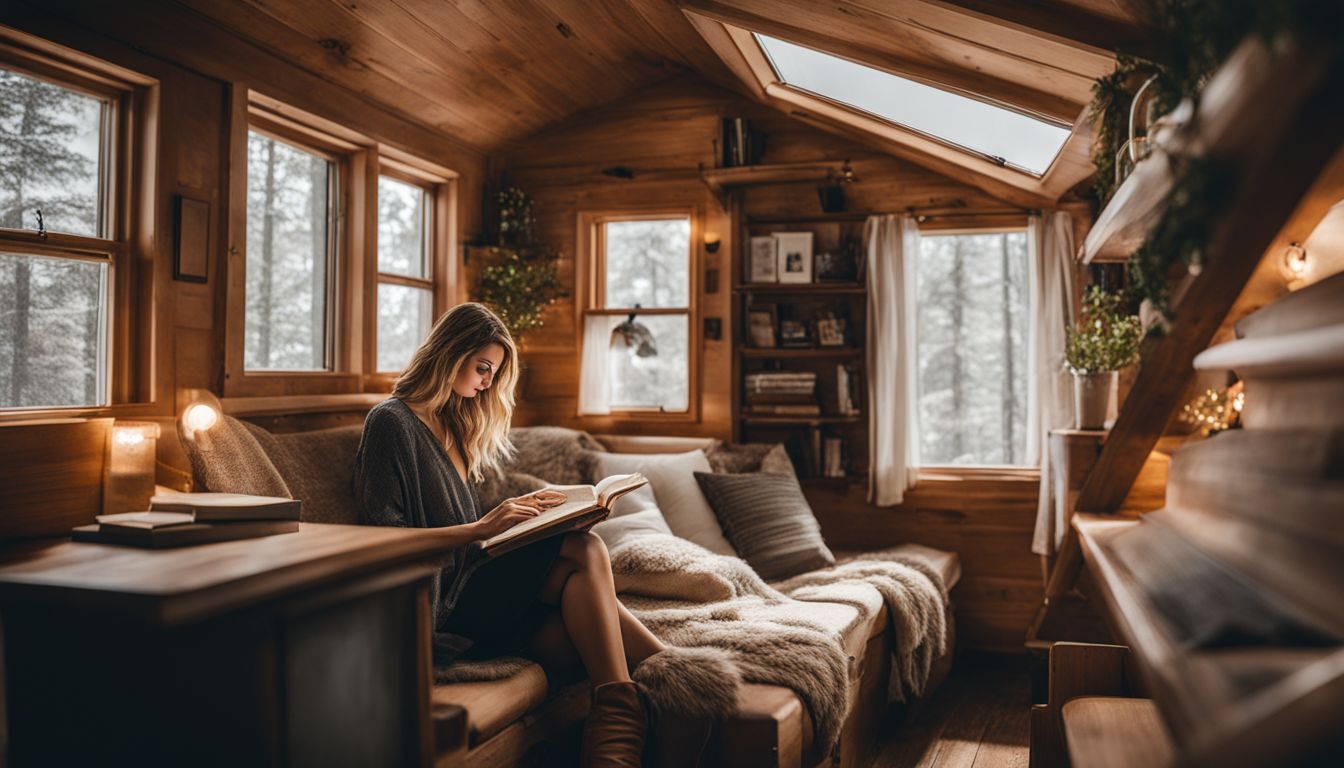
By: TinyNest Chronicles
Embracing the Small Home Movement: Tiny House Living at the Forefront
Many people feel their homes are too big and costly. The tiny house movement is growing fast. This article will show you the benefits of living in a smaller, simpler space. Read on to learn more!
Key Takeaways
- The Tiny House Movement has grown because people want simpler, more sustainable lives. It saves money and helps the planet by using less energy and fewer resources.
- Living in a tiny house encourages sharing with neighbors, reduces waste, and supports renewable energy like solar power.
- Remote work has made tiny house living even more appealing. People can work anywhere and enjoy flexibility while saving on costs.
- Tiny homes are becoming advanced with designs like movable units and home offices that fit modern needs.
- Choosing to live in a tiny home is about valuing experiences over things. This lifestyle promotes minimalism and intentional living.
Understanding the Tiny House Movement

The Tiny House Movement has rapidly gained momentum in recent years, driven by a desire for simplicity and sustainability. Its social and environmental implications have sparked conversations about redefining modern living.
The rise and evolution of the movement
Tiny houses started making waves as a way for people to live simply and save money. This movement, initially a minimalist trend, quickly grew into something bigger—a mix of affordable living and chic design.
Millennials especially caught on, drawn to the idea of decluttering their lives and focusing on sustainability. Tiny homes went from being mere spaces to live in to becoming statements about personal values and lifestyle choices.
Over time, these mini abodes evolved beyond just small wooden structures on land. Many now come equipped with wheels for a nomadic life or are designed as add-on units to existing properties, serving as guest quarters or offices.
The drive for more sustainable housing options pushed designers and builders to innovate, using recycled materials and creating smart layouts that make these compact spaces both functional and stylish.
The movement has shown no signs of slowing down, challenging traditional home buying norms and redefining what it means to have a fulfilling living space.
The social and environmental implications
Choosing a tiny home does more than just shrink living space; it fosters community and reduces our carbon footprint. Living small means using less energy for heating, cooling, and lighting.
It cuts down on the need for building materials which protects forests. I noticed in my own tiny house village, neighbors share tools and resources often. This tight-knit way of life strengthens bonds unlike any suburban block I’ve lived on.
Tiny houses also encourage sustainable habits like reducing waste and conserving water. Without room for excess, residents think twice before buying new items or wasting resources.
My solar panels produce almost all the electricity I need, showing that tiny living supports renewable energy use too. This lifestyle doesn’t just save money; it aligns with important environmental goals by significantly lowering one’s ecological footprint.
The Attraction of Tiny House Living

Tiny house living offers financial benefits through cost-effectiveness. It also promotes environmental sustainability and encourages a minimalist lifestyle.
The financial benefits and cost-effectiveness
Living in a tiny home saves money. Homeowners see lower utility bills and less spending on upkeep. Buying a house is cheaper when it’s small. This means you can put more cash towards what you love instead of a big mortgage.
Embracing tiny living let me prioritize experiences over stuff, dramatically cutting my costs.
Downsizing leads to simpler upkeep—an amenity not found in larger homes. You learn the value of each square foot and invest wisely in your space and belongings. Tiny house owners benefit from affordable housing options, making the dream of homeownership real for many.
The environmental benefits of small-space living
Transitioning from the financial benefits and cost-effectiveness, it’s vital to acknowledge the environmental advantages of small-space living. Embracing a minimalist lifestyle in a tiny house leads to reduced energy consumption and carbon footprint.
With fewer square feet to heat, cool, and light up, tiny homes promote sustainability by conserving resources and minimizing environmental impact. Furthermore, embracing simplicity in daily activities within limited space often translates into adopting eco-friendly practices – such as recycling and composting – contributing towards a greener way of living.
Living in a tiny home extends beyond downsizing; it significantly influences positive changes for both individuals and the environment. The simplified day-to-day existence prompts conscious choices that ultimately foster environmentally friendly habits while also reducing overall ecological strain.
Embracing simplicity and a minimalist lifestyle
Transitioning from the environmental benefits of small-space living to embracing simplicity and a minimalist lifestyle, it’s not just about downsizing – it’s a journey towards intentional, sustainable living.
Tiny house living promotes decluttering, allowing for an organized and greener way of life. By adopting this lifestyle, individuals are choosing experiences over material possessions and redefining what it means to lead a fulfilling life in today’s fast-paced world.
It’s more than just reducing space; it’s about realigning priorities and simplifying our daily existence.
Tiny house living enables a shift away from consumerism and materialism towards embracing sustainability and mindfulness. This lifestyle offers the opportunity to save money while focusing on meaningful experiences rather than accumulating belongings.
The Impact of Remote Work on the Tiny House Movement
Remote work has revolutionized the tiny house movement, offering newfound freedom and flexibility. Many individuals now see the opportunity to live in a tiny home without sacrificing their professional aspirations, thus driving the increasing popularity of small-space living.
Advantages of flexibility and mobility
Flexibility and mobility in tiny house living offer unique advantages. The ability to easily move your home allows for a dynamic lifestyle, exploring different locations, and enjoying new experiences while still providing the comfort of home.
Remote work is facilitated as you can live close to nature or travel without sacrificing your job. This freedom aligns with the minimalist philosophy, promoting a focus on experiences over material possessions.
Additionally, flexibility gives you the opportunity to respond quickly to changing circumstances or needs. Mobility enables connections with like-minded individuals at tiny house communities and events, fostering a sense of belonging and shared values within this growing movement.
These attributes enhance the overall appeal of tiny house living, offering an enriching way of life that transcends traditional notions of homeownership.
Keep in mind these benefits go hand in hand with sustainability — smaller homes often lead to reduced energy consumption while allowing occupants more financial flexibility.
The Future of the Tiny House Movement
The Tiny House Movement is evolving rapidly, embracing innovative concepts and tools to enhance small home living. Autonomous Accessory Dwelling Units (ADUs) and compact home offices are shaping the future of tiny house living, offering versatile solutions for modern lifestyles.
The movement is driven by a commitment to sustainability and adaptability, with an emphasis on maximizing space efficiency and fostering a sense of community within tiny house neighborhoods.
The rise of autonomous ADUs and small home offices
As remote work becomes more prevalent, the demand for autonomous accessory dwelling units (ADUs) and small home offices is on the rise. These compact spaces offer a practical solution for individuals seeking a dedicated workspace within their residential premises.
ADUs provide an independent living space, while small home offices cater to the need for a productive work environment close to home. This trend reflects the growing desire for flexible and versatile living arrangements suitable for both personal and professional activities.
Looking ahead, the development and integration of these autonomous ADUs and small home offices are set to redefine residential architecture by offering innovative solutions that align with evolving lifestyle needs…
Conclusion
The tiny house movement is not just a passing trend, but a serious lifestyle choice for many individuals. Living in a tiny home means less clutter, better organization, and greener living.
The roots of the movement originate as a minimalist revolution but have evolved into a blend of practical living and stylish design. Tiny homes offer the opportunity to save money and embrace a lifestyle that values simplicity and sustainability.